New England Weather & Climate
New England's weather and climate are much-discussed topics because they're so unpredictable. One thing is sure: the weather at the summit of Mount Washington will be astonishing.

A Snow Coach climbs Mount Washington in wintertime.
New England's climate is fairly straightfoward, and its seasons are distinct, each with its delights:
Spring
Fields come alive with color near Woodstock VT
Coming late in April or more commonly in May, and staying briefly into June, spring can be a delight or a disappointment. Farmers call it mud time because the thawing earth turns to mire, but it's sweet as well—it's when the farmers tap their maple trees for maple syrup.
The week or two of spring days in April, May and June are a delight, with cool temperatures in the evening and just the perfect degree of warmth during the day, in bright, clear sun.
But the delight of spring may be so brief that New Englanders joke "Oh, spring...yeah, last year it was on a Tuesday."
In the countryside the thaw brings "mud time," the period between frost and spring planting. Mud time is the slowest season for tourist facilities, coming after ski season and before summer warmth and school vacations bring out the city folk. Thus many country inns, resorts, and amusements close for a few weeks in April.
Summer
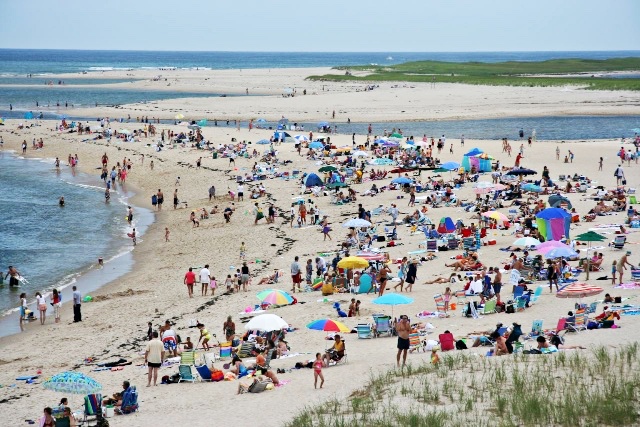
A hot summer day, cool sea water: summer in New England!
By mid-June, New England's climate is well into summer, and despite the region's northerly and coastal location, it can be pretty hot and sometimes quite humid in July and August.
July is reliably warmer, and August—particularly its middle and late weeks—is warmest of all. Everyone wonders how many "dog days" there will be, days of unremitting heat (85°F/30°C to 105°F/41°C) and humidity that slow down human activity and cause electrical power "brown-outs" (low-voltage problems).
There may be only a few dog days, or there may be a week or more. After three or four such days, New Englanders begin the noisy chorus of complaint—if they aren't on the beach, where the usually-frigid water can finally feel not frigid, but refreshing.

Swimming in Walden Pond, Concord MA.
Swimming in New England's many glacial lakes and ponds (such as Walden Pond in Concord MA) is usually pleasant, as the water is cool to warm.
Sailing, along the coast or on the rivers, is a choice activity.
A hike to the top of Mount Washington in New Hampshire's White Mountains, is takes a good deal of energy and vigor, as does even the ascent of Mount Monadnock.
A week at a beach on Narragansett Bay in Rhode Island. But a drive through the Massachusetts Berkshire Hills or along the Connecticut shoreline can also be satisfying.
Autumn (Fall)
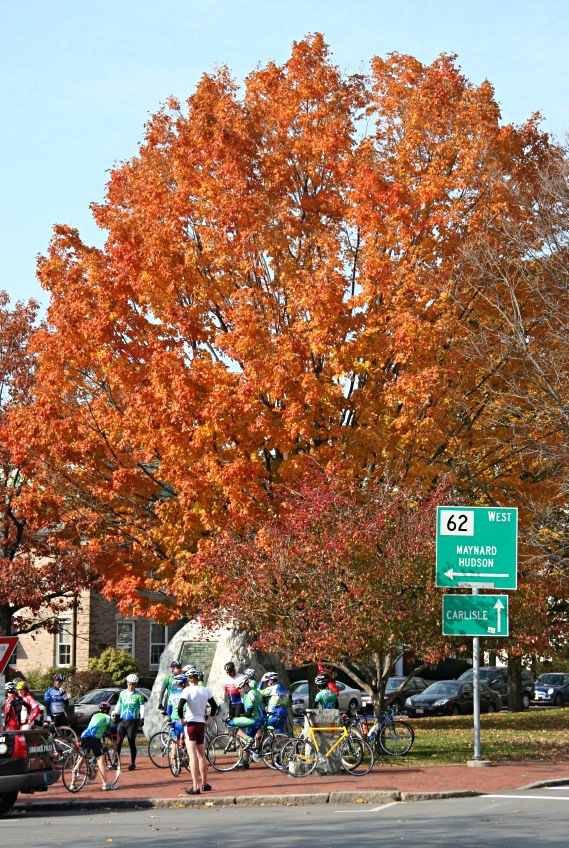
The finest gift of New England's climate: fall foliage season, a great time to go biking!
Autumn (September and October) is undoubtedly New England's glory and its finest season, and if you have a choice of vacation times this is the one to choose.
Although you may have to forsake swimming, autumnal sports such as biking, canoeing and hiking are best in autumn, and the famous fall foliage from September through November is worth it in itself.
Autumn days are still warm and pleasant, nights a bit chilly but not uncomfortably so (except perhaps in the mountains of northern New England—and almost certainly atop Mount Washington).
Fall Foliage Season
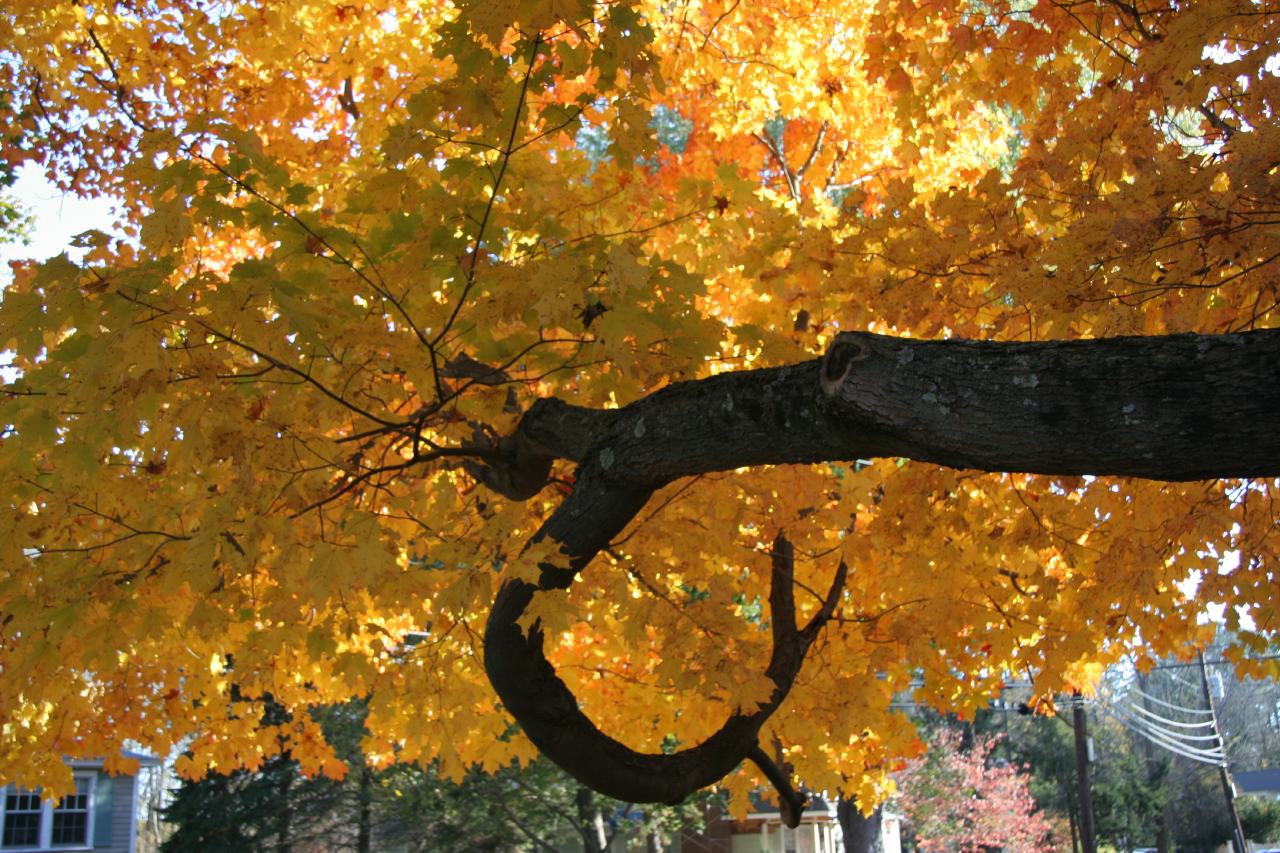
The six New England states offer one of nature's finest spectacles: the changing color of the fall foliage on its maple, beech, birch, oak, gum, willow, and other trees.
The season usually lasts from late September well into November.
Color Extravaganza
Vibrant reds, briliant yellows and muted tans and browns cover the branches. Countryside panoramas become blazing sweeps of color. Individual trees are like huge sun-lanterns. A single leaf can be a marvel.
The leaves die and fall to earth in a blizzard of fall foliage color that is one of earth's finest natural phenomena. The ground is covered in color, and you walk through it, scuffing the leaves about you, as though in a field of gold.
Harvest Weather
Throughout fall foliage season, days are still warm and pleasant, nights a bit chilly but not uncomfortably so. City people load their bikes into the car and head for the country, picking up fresh apple cider, pumpkins, and squash from farm stands on the way home.
Fresh cranberries are on sale in the markets all autumn, and although the blueberry-picking season is past, many apple orchards open so you can "pick-your-own" apples and get the freshest fruit possible at a low price. Many pick-your-own orchards feature fresh-squeezed apple cider for sale, along with apple pies, apple doughnuts and other fruit treats.
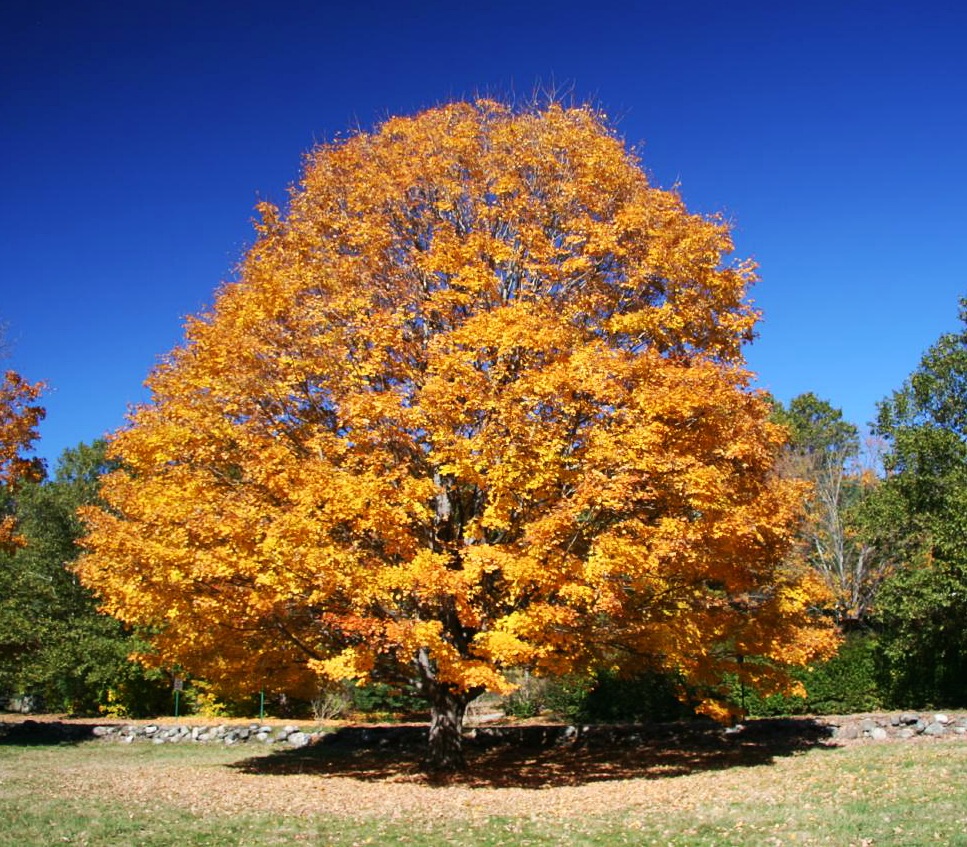
A maple tree explodes in color...
Color North to South
The cold touches the northern New England states of Vermont, New Hampshire and Maine first, and the color change starts there in September and moves southward and eastward through the region, with the peak of color in the northern states usually in late September and early October.
The peak comes a bit later in the southern states of Connecticut, Rhode Island and Massachusetts, often climaxing in mid-October—Columbus Day weekend is often thought to be the "peak," but there is little truth in this as peak color depends on the weather in a specific year, and your location in New England. There's usually plentiful color all the way through the end of October and the celebration of Hallowe'en.

Old Hill Burying Ground, Concord MA, in autumn foliage splendor...
In many years, fall foliage color extends well into November with some of the deepest, most glowing reds on maple, gum and oak trees coming then. You may not see whole forests in bright colors, and by mid- to late November some trees will be bare of leaves, but others will be at their blazing best. If severe wind and rain doesn't bring the leaves down, you may enjoy pockets of brilliant color in protected valleys right through Thanksgiving.
Fall Foliage Tours
Millions of people want to get away to the country for a weekend during foliage season, no matter where they live. Those who don't want to tangle with the traffic on fall weekends can take special bus and rail fall foliage tours from the major cities. More...
Where to Stay in Foliage Season
Most tourist resorts and inns stay open through September and often until Columbus Day weekend in mid-October. Those that stay open all year sometimes close for two weeks or so from November to early December to give the staff a break before the advent of ski season.
Here are tips on finding a hotel room at the last minute in foliage season.
Indian Summer

Picking the perfect pumpkin to make a Hallowe'en jack-o-lantern in New England.
After a period of chilly weather in October, and perhaps even a touch of frost, New England usually gets a respite, with a short period of warm weather known as Indian summer that can occur in late October or November.
It's not dependable, and it may be brief, but it's glorious all the same.
The best Indian summer is one that occurs near the end of foliage season, after Hallowe'en.
After the premonition of the cold months to come, late summer returns and beckons New Englanders out of their houses to enjoy the chill heavy dew of dawn, the last blaze of color in the trees, the scent of leaf-mold and woodsmoke in the air, the gentle rustle of falling leaves, the crackle of dry leaves underfoot, and the quiet retirement of the natural year.
The sweetest of all New England Indian summers are those that come late in November around Thanksgiving.
In rare years, the third week of November can have shirt-sleeve weather, with warm, abundant sun and the grateful feeling that we had received a priceless gift from nature.
By Thanksgiving in late November, everyone's getting in shape for the ski season and shopping for the holidays of Christmas, Hanukkah and New Year's.
Winter
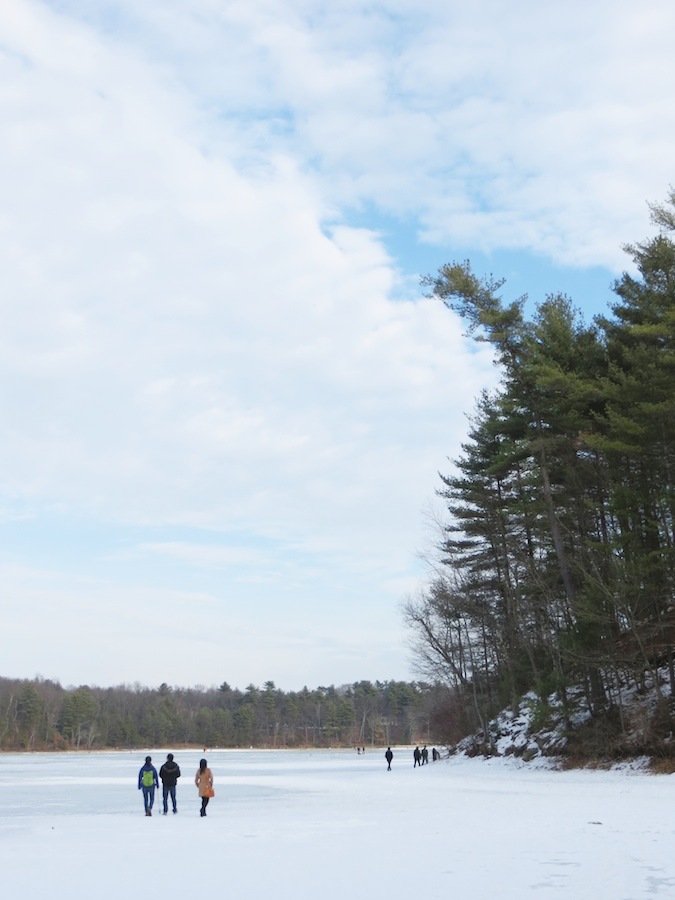
Strolling across frozen Walden Pond, Concord MA. (It's unsafe, but people do it.)
Winter, as they say, depends: the first snow flurries usually come in November in the north, mid-December in the south. January, February and March are cold and snowy.
Mid-Winter Thaw
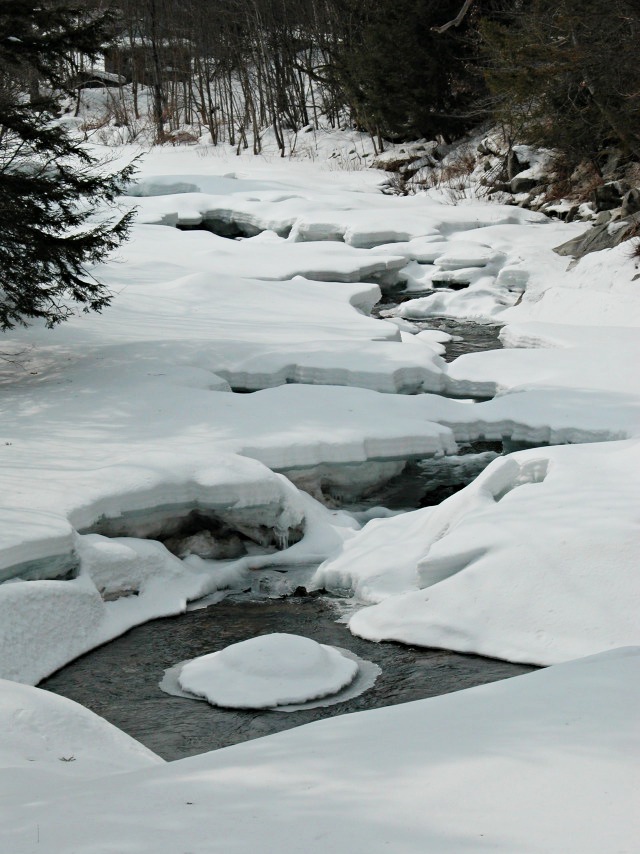
Mid-winter thaw can lighten up the white burden of winter in New England.
Sometimes called a "January thaw", it brings a respite from the often-intense freezing cold, a gift from New England's quirky climate to the snow-clad landscape.
During a mid-winter thaw, temperatures may rise into the 60°s F (15° C), or even the low 70°s F (20° C) in southern New England for a few days, melting snow and ice, bringing people out of doors to sit in the sun, and generally lightening the load of cold in a winter of New England's climate.
But there is no guarantee that any particular winter will have a mid-winter thaw. It may or may not happen—which is what makes it such a precious interlude when it does.
After the thaw, New Englanders go back to winter, the coldest of it, with frozen lakes and ponds—and, in a particularly cold winter, frozen rivers—but also abundant snow on the ski slopes of the northern states (Vermont, New Hampshire, Maine).
If the snow is a nuisance in the cities and a burden to workers in country towns, it is also beautiful, dramatic, and just the thing for outdoor winter sports: downhill skiing, cross-country (Nordic) skiing, snowboarding, snow-shoeing, snow-tubing and air-boarding.
Even if your favorite part of winter is sitting in a pleasant country inn, next to a crackling wood fire, sipping a cup of hot chocolate, you'll still recall with pleasure the warm respite of a New England mid-winter thaw.
Mount Washington Weather
None of the normal information about New England's climate applies to New Hampshire's Mount Washington, said to have the worst, most extreme weather in all the USA. More...
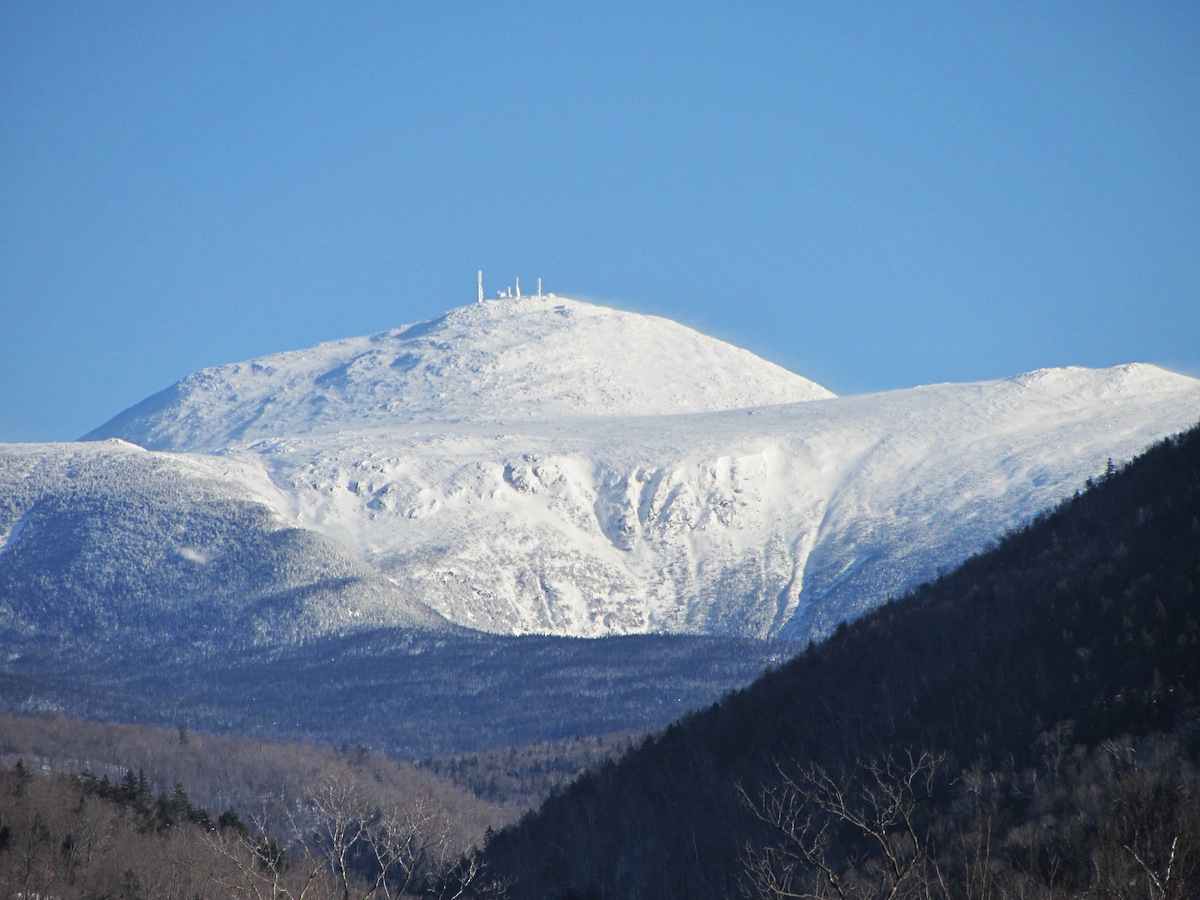
Sun at base, snow at summit: Mount Washington!
